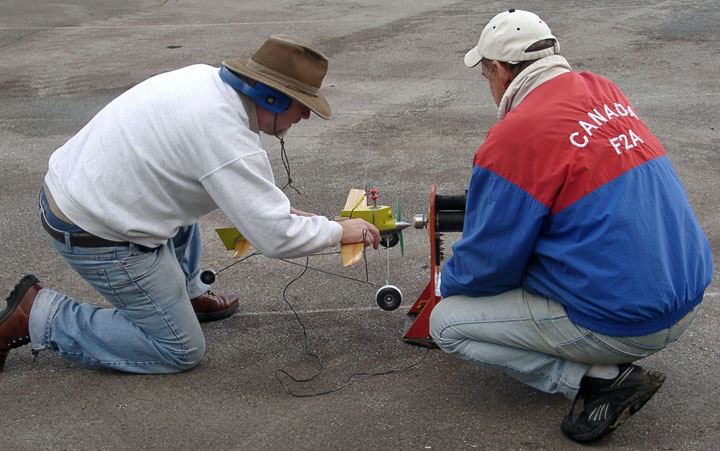

Ken Burdick puts the spinner of a C Speed plane into the starter, operated by Chris Sackett, at a recent test session. Barry Hobkirk photo.
By Ken Burdick
Yes Folks, it's true.
The C-Bees, otherwise known as C speed fliers, are beginning to post times.
 In the Northwest we have Kenny-b with his Nelson-powered ship with somewhere around 165 mph. Further North "the Hippy" Marty Higgs has just turned his ultra cool Xizang to around 165 on Nov. 7, 2010. In the So-Cal area, Karl Caldwell has a 150-ish flight due to needle setting issues.
In the Northwest we have Kenny-b with his Nelson-powered ship with somewhere around 165 mph. Further North "the Hippy" Marty Higgs has just turned his ultra cool Xizang to around 165 on Nov. 7, 2010. In the So-Cal area, Karl Caldwell has a 150-ish flight due to needle setting issues.
Where are the Arizona boys???????
Marty has a true classic engine. A Bill Wisniewski K&B that has the special subport induction and wild porting. These engines are rare and as the Rock Star (Paul Gibeault) has shown repeatedly in Formula 40, they really go. Actually, Paul's engine is his own work with a Nelson back door, and a real screamer.
No, they bite, and once bitten by flying one at high speed you become hooked on a very cool event and set of equipment. I was ignorant of this until my Nelson FIRE jumped up and wowed me, the Hippy was ignorant of this until last weekend when his K&B went nuts for about five laps. One of the old guard was witness to this (Chris Sackett, known around these parts as Partner) watched Marty's screaming C and actually thought it was on a 65 ft line instead of a 70 because it was that quick. So impressed was Partner, that he made a deal with the two of us. “If y'all finish those .21 proto's, and fly them, I'll build a C ship.
For those of you who don't know, Partner has been a mainstay in the speed community for decades and has built many record holders, it's going to be cool to see what this master modeler comes up with for a C speedster.

Ken Burdick's C Speed plane, powered by Nelson. It is a converted Formula 40 ship. Barry Hobkirk photo.

Marty Higgs' Xizang, in the dolly ready for a flight. Barry Hobkirk photo.
Some interesting similarities between the Nelson flights and the K&B flights were observed. The Nelson was running too rich for all three flights. It came on once and was very fast. The K&B that was also set up for Formula 40, was too rich and came on hard for the last five laps. This is most likely head clearance and or plug temperature range. The Nelson has a standard Henry set head, but since I didn't buy the engine from him, it will make a trip back to see its creator for a checkup. Marty agrees with Ned Morris (deceased) and the Rock Star, that the K&B needs to be “run hard.” Ned ran his engines with the head set extremely close.
What this may also require is better pit staging of the engine. Get it good and hot in the dolly, then open the needle valve to the run setting. Many engines respond to this technique but it would require an external needle that can be manipulated by the needle man. When Scott Newkirk tried this on my Nelson, it died rich in the dolly. When I used the nose up and shake it some technique on Marty's ship, it sounded great but died rich after one lap and came out of the dolly very rich.
Lots to do and we are still learning this set up as we go, but a common perception is that the ships fly very nicely. Just put it in the groove, then hang on to the smooth flying speed plane. No jumpy of takeoff as in some F-40's, monoline makes a good ship simple to fly, and a lift out dolly is as smooth as taking off a stunt ship. The fairly light pull lets you get to the pylon without the brute pull of a D ship holding you up.
Let's hear your results and plan a few contests.
-- Kenny-b
This page was upated Nov. 10in, 2010